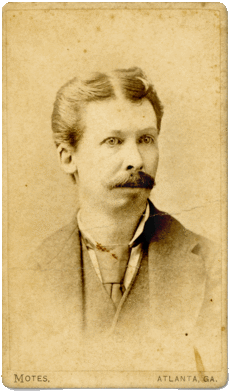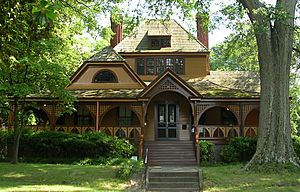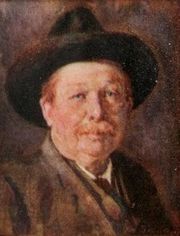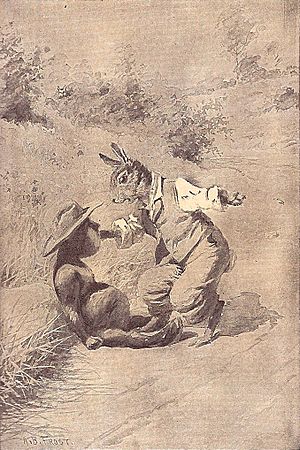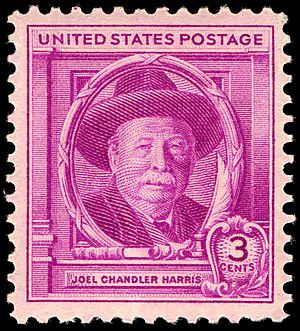Joel Chandler Harris facts for kids
Quick facts for kids
Joel Chandler Harris
|
|
|---|---|
 |
|
| Born | December 9, 1848 Eatonton, Georgia, United States |
| Died | July 3, 1908 (aged 59) Atlanta, Georgia, United States |
| Occupation | Journalist, fiction writer, folklorist |
| Notable works | Uncle Remus: His Songs and His Sayings Nights with Uncle Remus |
| Children | Julian LaRose Harris |
| Relatives | Julia Collier Harris (daughter-in-law) |
| Signature | |
 |
|
Joel Chandler Harris (December 9, 1848 – July 3, 1908) was an American journalist, fiction writer, and folklorist best known for his collection of Uncle Remus stories. Born in Eatonton, Georgia, where he served as an apprentice on a plantation during his teenage years, Harris spent most of his adult life in Atlanta working as an associate editor at The Atlanta Constitution.
Harris led two professional lives: as the editor and journalist known as Joe Harris, he supported a vision of the New South with the editor Henry W. Grady (1880–1889), which stressed regional and racial reconciliation after the Reconstruction era. As Joel Chandler Harris, fiction writer and folklorist, he wrote many 'Brer Rabbit' stories from the African-American oral tradition.
Contents
Life
Education: 1848–1862
Joel Chandler Harris was born in Eatonton, Georgia in 1848 to Mary Ann Harris, an Irish immigrant. His father, whose identity remains unknown, abandoned Mary Ann and the infant shortly after his birth. The parents had never married; the boy was named Joel after his mother's attending physician, Dr. Joel Branham. Chandler was the name of his mother's uncle. Harris remained self-conscious of his illegitimate birth throughout his life.
A prominent physician, Dr. Andrew Reid, gave the Harris family a small cottage to use behind his mansion. Mary Harris worked as a seamstress and helped neighbors with their gardening to support herself and her son. She was an avid reader and instilled in her son a love of language: "My desire to write—to give expression to my thoughts—grew out of hearing my mother read The Vicar of Wakefield."
Dr. Reid also paid for Harris' school tuition for several years. In 1856, Joe Harris briefly attended Kate Davidson's School for Boys and Girls, but transferred to Eatonton School for Boys later that year. He had an undistinguished academic record and a habit of truancy. Harris excelled in reading and writing, but was mostly known for his pranks, mischief, and sense of humor. Practical jokes helped Harris cloak his shyness and insecurities about his red hair, Irish ancestry, and illegitimacy, leading to both trouble and a reputation as a leader among the older boys.
Turnwold Plantation: 1862–1866
At the age of 14, Harris quit school to work. In March 1862, Joseph Addison Turner, owner of Turnwold Plantation nine miles east of Eatonton, hired Harris to work as a printer's devil for his newspaper The Countryman. Harris worked for clothing, room, and board. The newspaper reached subscribers throughout the Confederacy during the American Civil War; it was considered one of the larger newspapers in the South, with a circulation of about 2,000. Harris learned to set type for the paper, and Turner allowed him to publish his own poems, book reviews, and humorous paragraphs.
Turner's instruction and technical expertise exerted a profound influence on Harris. During his four-year tenure at Turnwold Plantation, Joel Harris consumed the literature in Turner's library. He had access to Chaucer, Dickens, Sir Thomas Browne, Arabian Nights, Shakespeare, Milton, Swift, Thackeray, and Edgar Allan Poe. Turner, a fiercely independent Southern loyalist and eccentric intellectual, emphasized the work of southern writers, yet stressed that Harris read widely. In The Countryman Turner insisted that Harris not shy away from including humor in his journalism.
While at Turnwold Plantation, Harris spent hundreds of hours in the slave quarters during time off. He was less self-conscious there and felt his humble background as an illegitimate, red-headed son of an Irish immigrant helped foster an intimate connection with the slaves. He absorbed the stories, language, and inflections of people like Uncle George Terrell, Old Harbert, and Aunt Crissy. The African-American animal tales they shared later became the foundation and inspiration for Harris's Uncle Remus tales. George Terrell and Old Harbert in particular became models for Uncle Remus, as well as role models for Harris.
Savannah and the South: 1866–1876
Joseph Addison Turner shut down The Countryman in May 1866. Joel Harris left the plantation with useless Confederate money and very few possessions.
The Macon Telegraph hired Harris as a typesetter later that year. Harris found the work unsatisfactory and himself the butt of jokes around the office, in no small part due to his red hair. Within five months, he accepted a job working for the New Orleans Crescent Monthly, a literary journal. Just six months after that, homesick, he returned to Georgia, but with another opportunity at the Monroe Advertiser, a weekly paper published in Forsyth, Georgia.
At the Advertiser Harris found a regional audience with his column "Affairs of Georgia." Newspapers across the state reprinted his humorous paragraphs and political barbs. Harris' reputation earned him the position of associate editor at the Savannah Morning News, the largest circulation newspaper in Georgia. Though he relished his position in Forsyth, Joe Harris accepted the $40-a-week job, a significant pay increase, and quickly established himself as Georgia's leading humor columnist while at the Morning News.
In 1872 Harris met Mary Esther LaRose, a seventeen-year-old French-Canadian from Quebec. After a year of courtship, Harris and LaRose married in April 1873. LaRose was 18 and Harris, 27 (though publicly admitting to 24). Over the next three years, the couple had two children. Their life in Savannah came to an abrupt halt, however, when they fled to Atlanta to avoid a yellow fever epidemic.
Atlanta: 1876–1908
In 1876 Harris was hired by Henry W. Grady at The Atlanta Constitution, where he would remain for the next 24 years. He worked with other journalists including Frank Lebby Stanton, who was in turn an associate of James Whitcomb Riley. Chandler supported the racial reconciliation envisioned by Grady. He often took the mule-drawn trolley to work, picked up his assignments, and brought them home to complete. He wrote for the Constitution until 1900.
In addition, he published local-color stories in magazines such as Scribner's, Harper's, and The Century.
Uncle Remus stories and later years
Not long after taking the newspaper appointment, Harris began writing the Uncle Remus stories as a serial to "preserve in permanent shape those curious mementoes of a period that will no doubt be sadly misrepresented by historians of the future." The tales were reprinted across the United States, and Harris was approached by publisher D. Appleton and Company to compile them for a book.
Uncle Remus: His Songs and His Sayings was published near the end of 1880. Hundreds of newspapers reviewed the best-seller, and Harris received national attention. Of the press and attention Walter Hines Page noted, "Joe Harris does not appreciate Joel Chandler Harris."
Royalties from the book were modest, but allowed Harris to rent a six-room house in West End, an unincorporated village on the outskirts of Atlanta, to accommodate his growing family. Two years later Harris bought the house and hired the architect George Humphries to transform the farmhouse into a Queen Anne Victorian in the Eastlake style. The home, soon thereafter called The Wren's Nest, was where Harris spent most of his time.
Harris preferred to write at the Wren's Nest. He published prodigiously throughout the 1880s and 1890s, trying his hand at novels, children's literature, and a translation of French folklore. Yet he rarely strayed from home and work during this time. He chose to stay close to his family and his gardening. Harris and his wife Essie had seven more children in Atlanta, with a total of six (out of nine) surviving past childhood.
By the late 1890s, Harris was tired of the newspaper grind and suffered from health problems. At the same time, he grew more comfortable with his creative persona.
Harris retired from the Constitution in 1900. He continued experimenting with novels and wrote articles for outlets such as The Saturday Evening Post. Still, he remained close to home, refusing to travel to accept honorary degrees from the University of Pennsylvania and Emory College (now Emory University). In 1905 Harris was elected to the American Academy of Arts and Letters.
Harris traveled to accept an invitation to the White House by President Theodore Roosevelt. Two years earlier, Roosevelt had said, "Presidents may come and presidents may go, but Uncle Remus stays put. Georgia has done a great many things for the Union, but she has never done more than when she gave Mr. Joel Chandler Harris to American literature."
On July 3, 1908, Joel Chandler Harris died of acute nephritis and complications from cirrhosis of the liver. In his obituary, The New York Times Book Review echoed Roosevelt's sentiment, stating: "Uncle Remus cannot die. Joel Chandler Harris has departed this life at the age of 60 ... but his best creation, [Uncle Remus] with his fund of folk-lore, will live in literature."
Writing
Folklore
Harris created the first version of the Uncle Remus character for The Atlanta Constitution in 1876 after inheriting a column formerly written by Samuel W. Small, who had taken leave from the paper. In these character sketches, Remus would visit the newspaper office to discuss the social and racial issues of the day. By 1877, Small had returned to the Constitution and resumed his column.
Harris did not intend to continue the Remus character. But when Small left the paper again, Harris reprised Remus. He realized the literary value of the stories he had heard from the slaves of Turnwold Plantation. Harris set out to record the stories and insisted that they be verified by two independent sources before he would publish them. He found the research more difficult given his professional duties, urban location, race and, eventually, fame.
On July 20, 1879, Harris published "The Story of Mr. Rabbit and Mr. Fox as Told by Uncle Remus" in The Atlanta Constitution. It was the first of 34 plantation fables that would be compiled in Uncle Remus: His Songs and His Sayings (1880). The stories, mostly collected directly from the African-American oral storytelling tradition, were revolutionary in their use of dialect, animal personages, and serialized landscapes.
Remus' stories featured a trickster hero called Br'er Rabbit (Brother Rabbit), who used his wits against adversity, though his efforts did not always succeed. Br'er Rabbit is a direct interpretation of Yoruba tales of Hare, though some others posit Native American influences as well. The scholar Stella Brewer Brookes asserts, "Never has the trickster been better exemplified than in the Br'er Rabbit of Harris." Br'er Rabbit was accompanied by friends and enemies, such as Br'er Fox, Br'er Bear, Br'er Terrapin, and Br'er Wolf. The stories represented a significant break from the fairy tales of the Western tradition: instead of a singular event in a singular story, the critters on the plantation existed in an ongoing community saga, time immemorial.
Harris described Harriet Beecher Stowe's novel, Uncle Tom's Cabin, as a major influence on the characters of Uncle Remus and the Little Boy. When he read Stowe's novel in 1862, he said that it "made a more vivid impression upon my mind than anything I have ever read since." Interpreting Uncle Tom's Cabin as a "wonderful defense of slavery," Harris argued that Stowe's "genius took possession of her and compelled her, in spite of her avowed purpose, to give a very fair picture of the institution she had intended to condemn". In Harris's view, the "real moral that Mrs. Stowe's book teaches is that the ... realities [of slavery], under the best and happiest conditions, possess a romantic beauty and tenderness all their own."
The Uncle Remus stories garnered critical acclaim and achieved popular success well into the 20th century. Harris published at least twenty-nine books, of which nine books were compiled of his published Uncle Remus stories, including Uncle Remus: His Songs and His Sayings (1880), Nights with Uncle Remus (1883), Uncle Remus and His Friends (1892), The Tar Baby and Other Rhymes of Uncle Remus (1904), Told by Uncle Remus: New Stories of the Old Plantation (1905), Uncle Remus and Brer Rabbit (1907). The last three books written by Joel Chandler Harris were published after his death which included Uncle Remus and the Little Boy (1910), Uncle Remus Returns (1918), and Seven Tales of Uncle Remus (1948). The tales, 185 in sum, became immensely popular among both black and white readers in the North and South. Few people outside of the South had heard accents like those spoken in the tales, and the dialect had never been legitimately and faithfully recorded in print. To Northern and international readers, the stories were a "revelation of the unknown." Mark Twain noted in 1883, "in the matter of writing [the African-American dialect], he is the only master the country has produced."
The stories introduced international readers to the American South. Rudyard Kipling wrote in a letter to Harris that the tales "ran like wild fire through an English Public school. ... [We] found ourselves quoting whole pages of Uncle Remus that had got mixed in with the fabric of the old school life." The Uncle Remus tales have since been translated into more than forty languages.
James Weldon Johnson called the collection "the greatest body of folklore America has produced".
Journalism
Early in his career at the Atlanta Constitution, Joe Harris laid out his editorial ideology and set the tone for an agenda that aimed to help reconcile issues of race, class, and region: "An editor must have a purpose. ... What a legacy for one's conscience to know that one has been instrumental in mowing down the old prejudices that rattle in the wind like weeds."
Harris served as assistant editor and lead editorial writer at The Atlanta Constitution primarily between 1876 and 1900. He published articles intermittently until his death in 1908. While at the Constitution, Harris, "in thousands of signed and unsigned editorials over a twenty-four-year period, ... set a national tone for reconciliation between North and South after the Civil War".
Throughout his career, Harris actively promoted racial reconciliation as well as African-American education, suffrage, and equality. He regularly denounced racism among southern whites, condemned lynching, and highlighted the importance of higher education for African Americans, frequently citing the work of W.E.B. Du Bois in his editorials. In 1883, for example, the New York Sun had an editorial: "educating the negro will merely increase his capacity for evil." The Atlanta Constitution editorial countered with: if "education of the negro is not the chief solution of the problem that confronts the white people of the South then there is no other conceivable solution and there is nothing ahead but political chaos and demoralization."
Harris's editorials were often progressive in content and paternalistic in tone. He was committed to the "dissipation of sectional jealousy and misunderstanding, as well as religious and racial intolerance", yet "never entirely freed himself of the idea that the [southern whites] would have to patronize the [southern blacks]."
In 1904 Harris wrote four important articles for The Saturday Evening Post discussing the problem of race relations in the South; these highlighted his progressive yet paternalistic views. Of these, Booker T. Washington wrote to him:
It has been a long time since I have read anything from the pen of any man which has given me such encouragement as your article has. ... In a speech on Lincoln's Birthday which I am to deliver in New York, I am going to take the liberty to quote liberally from what you have said.
Two years later, Harris and his son Julian founded what would become Uncle Remus's Home Magazine. Harris wrote to Andrew Carnegie that its purpose would be to further "the obliteration of prejudice against the blacks, the demand for a square deal, and the uplifting of both races so that they can look justice in the face without blushing." Circulation reached 240,000 within one year, making it one of the largest magazines in the country.
Other works
Harris wrote novels, narrative histories, translations of French folklore, children's literature, and collections of stories depicting rural life in Georgia. The short stories "Free Joe and the Rest of the World", "Mingo", and "At Teague Poteets" are the most influential of his non-Uncle Remus creative work. Many of his short stories delved into the changing social and economic values in the South during Reconstruction. Harris's turn as a local colorist gave voice to poor white characters and demonstrated his fluency with different African-American dialects and characters.
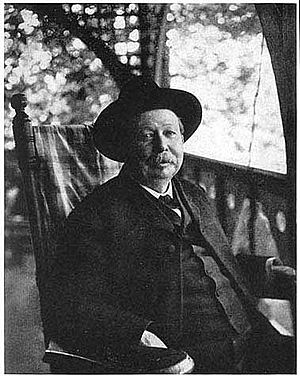
Influence
Children's literature analyst John Goldthwaite argues that the Uncle Remus tales are "irrefutably the central event in the making of modern children's story." Harris's influence on British children's writers such as Kipling, Milne, Potter, Burgess and Blyton is substantial. His influence on modernism is less overt, but also evident in the works of Pound, Eliot, Joyce, and Faulkner.
Beatrix Potter illustrated eight scenes from the Uncle Remus stories between 1893 and 1896, coinciding with her first drawings of Peter Rabbit. Potter's family had favored the Uncle Remus stories during her youth, and she was particularly impressed by the way Harris turned "the ordinary into the extraordinary." Potter borrowed some of the language from the Uncle Remus stories, adopting the words: "cottontail," "puddle-duck," and "lippity-(c)lippity" into her own work.
Mark Twain incorporated several of the Uncle Remus stories into readings during his book tour. He wrote to William Dean Howells in the early 1880s, reporting that the "Tar Baby" had been received "best of all" at a reading in Hartford. Twain admired Harris' use of dialect. He appropriated exchanges and turns of phrase in many of his works, most notably in Adventures of Huckleberry Finn and The Mysterious Stranger.
A.A. Milne borrowed diction, plot, and narrative structure from several Brer Rabbit stories. "Pooh Goes Visiting" and "Heyo, House!" are particularly similar. As a boy, Milne recalled listening to his father read one Uncle Remus story per night, and referred to it as "the sacred book."
Charles Chesnutt's most famous work, The Conjure Woman, is strongly influenced by the Uncle Remus tales; he features Uncle Julius as the main character and storyteller. Chesnutt read the Uncle Remus stories to his own children.
Many scholars cite Harris' influence on William Faulkner, most importantly in terms of dialect usage, depictions of African Americans, lower-class whites, and fictionalized landscape.
Poets Ezra Pound and T. S. Eliot corresponded in Uncle Remus-inspired dialect, referring to themselves as "Brer Rabbit" and "Old Possum," respectively. Eventually the dialect and the personae became a sign of their collaboration against the London literary establishment. Eliot titled one of his books Old Possum's Book of Practical Cats.
Ralph Bakshi wrote and directed a 1975 American live action/animated crime film titled Coonskin based on Harris' Brothers rabbit, fox, and bear who rise to the top of the organized crime racket in Harlem, encountering corrupt law enforcement, con artists, and the Mafia.
Song of the South
In 1946, the Walt Disney Company produced a film based on the Uncle Remus tales called Song of the South. While commercially successful during its original release and re-releases, the film has never been released for home consumption in the United States as, since its release, the film was criticized for the way it portrays its characters and the Southern U.S. in regard to slavery. Song of the South has been released on video in a number of overseas markets, and on LaserDisc in Japan.
The film earned mixed critical reviews and two Academy Awards. James Baskett won an honorary Academy Award for his portrayal of Uncle Remus, and "Zip-A-Dee-Doo-Dah" was presented with the award for Best Original Song. Walter White of the NAACP acknowledged "the remarkable artistic merit" of the film in his telegraphed press release on November 27, 1946, but decried the "impression it gives of an idyllic master-slave relationship."
Since its debut, the public perception of Harris and the Uncle Remus stories has largely been tied to the reception of Song of the South.
Legacy and honors
- The Wren's Nest, Harris's home in the historic West End neighborhood of Atlanta, Georgia, has been designated a National Historic Landmark. It has been operated as a museum home since 1913.
- Uncle Remus Museum in Eatonton, GA commemorates the life of Harris.
- A state historic landmark plaque was erected in Savannah, GA on Bay Street across from the now demolished Savannah Morning News building where Harris worked in that city.
- The U.S. Post Office issued a 3-cent stamp commemorating Joel Chandler Harris on the 1948 100th anniversary of his birth.
- A state historic landmark plaque was erected in Forsyth, GA on Main Street at N 33° 2.057', W 83° 56.354'. The plaque reads: One block east stood the old office of The Monroe Advertiser, where Joel Chandler Harris, creator of "Uncle Remus," came in 1867, as a boy of nineteen, to work until 1870. Here he advanced from printer's devil to accomplished journalist. Of his duties, Harris said: "I set all the type, pulled the press, kept the books, swept the floor and wrapped the papers for mailing." His typestand is still in use at the present office of The Monroe Advertiser.
Selected list of works
- Uncle Remus: His Songs and His Sayings (1880)
- Nights with Uncle Remus (1883)
- Mingo and Other Sketches in Black and White (1884)
- Free Joe and Other Georgian Sketches (1887)
- Daddy Jake, The Runaway: And Short Stories Told After Dark (1889)
- Joel Chandler Harris' Life of Henry W. Grady (1890)
- Balaam and His Master and Other Sketches and Stories (1891)
- On the Plantation: A Story of a Georgia Boy's Adventures During the War (1892)
- Uncle Remus and His Friends (1892)
- Little Mr. Thimblefinger and his Queer Country: What the Children Saw and Heard There (Houghton Mifflin, 1894), illustrated by Oliver Herford,
- Mr. Rabbit at Home (1895), illus. Herford – sequel to Mr. Thimblefinger,
- Sister Jane: Her Friends and Acquaintances (1896)
- The Story of Aaron (so named): The Son of Ben Ali (1896), illus. Herford,
- Aaron in the Wildwoods (1897), illus. Herford – sequel,
- Tales of the Home Folks in Peace and War (1898)
- The Chronicles of Aunt Minervy Ann (1899)
- Plantation Pageants (1899)
- On the Wing of Occasions (1900)
- Gabriel Tolliver (1902)
- The Making of a Statesman and Other Stories (1902)
- Wally Wanderoon and His Story-Telling Machine (1903)
- A Little Union Scout (1904)
- The Tar-Baby and Other Rhymes of Uncle Remus (1904)
- Told By Uncle Remus: New Stories of the Old Plantation (1905)
- Uncle Remus and Brer Rabbit (1907)
- Shadow Between His Shoulder Blades (1909)
- Uncle Remus and the Little Boy (1910)
- Uncle Remus Returns (1918)
- Seven Tales of Uncle Remus (1948)
See also
 In Spanish: Joel Chandler Harris para niños
In Spanish: Joel Chandler Harris para niños


